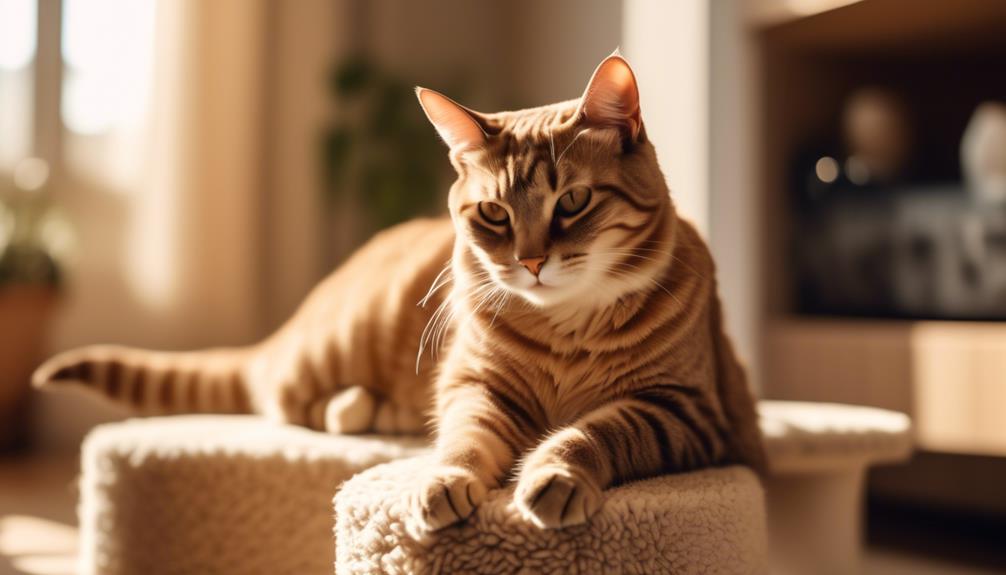How To Stop A Cat From Scratching Furniture

How To Stop A Cat From Scratching Furniture? Are you tired of your furniture becoming a feline scratching post? It’s time to put an end to this destructive behavior and save your beloved couch from further damage. But how, you ask? Well, fear not, for there are effective strategies that can help you reclaim your furniture and keep your cat happy at the same time. So, if you’re ready to discover the secrets of stopping a cat from scratching furniture, keep on reading to find out how you can restore peace and harmony to your home.
Understand the Reasons Behind Cat Scratching
To understand why cats scratch, it is important to recognize that they do it for various reasons, including exercise, marking their territory, maintaining claw health, relieving stress, and expressing their innate instincts. Scratching is a natural behavior for cats and serves multiple purposes. Firstly, when cats scratch, they provide exercise and stretching for their muscles and tendons. This helps them stay agile and limber, preventing any muscle stiffness or joint problems. Secondly, scratching allows cats to mark their territory. They have scent glands on their paws, and by scratching, they leave behind their scent, signaling to other cats that the area is claimed. This behavior helps them establish their dominance and maintain a sense of ownership over their territory.
Additionally, scratching also helps cats maintain their claw health. By shedding the outer nail husk, they keep their claws sharp and ready for hunting or self-defense. It is a way for them to keep their claws in optimal condition. Moreover, scratching serves as a stress reliever for cats. It helps them release pent-up energy and frustration, preventing them from engaging in unwanted behaviors such as aggression or excessive grooming. Lastly, scratching is an instinctual behavior for cats. It is deeply ingrained in their nature, and they find it pleasurable and satisfying.
Understanding the reasons behind cat scratching is crucial when it comes to preventing cats from scratching furniture. By providing alternative scratching surfaces such as scratching posts or boards, you can redirect their behavior and protect your furniture. It is essential to choose scratching surfaces that mimic the texture and material of the furniture they are inclined to scratch. By addressing their scratching needs, you can prevent cats from damaging your furniture and provide them with a suitable outlet for their natural instincts.
Provide Appropriate Scratching Alternatives
To prevent your cat from scratching furniture, it’s important to provide appropriate scratching alternatives. Scratching posts are a great option, as they give your cat a designated place to scratch. Make sure to choose posts with different surfaces and place them in areas where your cat already likes to scratch or relax. Additionally, using catnip spray or hanging toys on the posts can make them more enticing for your cat to use.
Scratching Posts
Consider providing your cat with a variety of appropriate scratching posts to deter them from scratching your furniture. Scratching is a natural behavior for cats, so it’s important to offer them alternatives that meet their needs. When choosing scratching posts, consider different textures like carpet, cardboard, or sisal to cater to your cat’s preferences. Place the scratching posts strategically in areas where your cat likes to scratch or relax, making them more appealing.
Encourage your cat to use the scratching posts by using positive reinforcement, such as treats or praise, whenever they scratch the posts. Remember to avoid punishment and focus on reinforcing the desired behavior of using the scratching posts. By providing appropriate scratching alternatives, you can redirect your cat’s scratching behavior away from your furniture and keep both your cat and your furniture happy.
Catnip Spray
Using catnip spray on scratching posts can make them more appealing to your cat and encourage healthy scratching behavior. Catnip spray provides a natural and enticing scent that cats love, making the scratching post a more attractive option for them.
By applying catnip spray on the appropriate scratching surfaces, you can redirect your cat’s scratching instincts away from your furniture and towards their designated scratching posts. This is a safe and effective way to provide your cat with appropriate scratching alternatives. The catnip spray acts as a training tool, teaching your cat where it is acceptable to scratch. By consistently using catnip spray on the scratching post, you can help stop your cat from scratching your furniture and train them to use the designated area instead.
Use Deterrents to Discourage Furniture Scratching
To discourage your cat from scratching furniture, you can use deterrents like a spray bottle or sticky tape. When your cat starts scratching, give them a quick spray of water to deter them from continuing. Alternatively, you can apply double-sided tape or Sticky Paws to the areas you want to protect, as cats dislike the sticky sensation.
Spray Bottle Method
To discourage furniture scratching, a spray bottle filled with water can be a useful tool in redirecting your cat’s behavior. When you catch your cat scratching the furniture, simply spray them with a mist of water from the bottle. This method works by creating a negative association with the act of scratching. Cats generally dislike being sprayed with water, so they will start to associate scratching the furniture with an unpleasant experience. It’s important to be consistent and use the spray bottle as a deterrent every time you catch your cat attempting to scratch the furniture.
Make sure the spray bottle is readily available so you can quickly respond to the scratching behavior. This method can help you train your cat to stop scratching your furniture and redirect their attention to appropriate scratching surfaces.
Sticky Tape Solution
After using the spray bottle method to discourage your cat from scratching furniture, another effective solution to consider is the Sticky Tape Solution, which uses deterrents to discourage this behavior. Applying double-sided tape to the furniture can be an effective way to stop scratching. Cats dislike the sticky texture and will be deterred from scratching the furniture. You can also try using products like Sticky Paws, which are specially designed to deter cats from scratching.
These products adhere to the furniture and provide a sticky surface that cats find unpleasant. Additionally, it is essential to provide alternative scratching surfaces, such as scratching posts or boards, to redirect your cat’s behavior effectively. By combining deterrents with positive reinforcement, such as praise and treats when your cat uses the appropriate scratching surfaces, you can train them to abandon the habit of scratching furniture. Remember to reapply the deterrents as needed and monitor your cat’s behavior to ensure the effectiveness of the Sticky Tape Solution.
Trim Your Cat’s Nails Regularly
Are you wondering how to effectively trim your cat’s nails to prevent furniture damage and promote claw health? Regularly trimming your cat’s nails is an essential part of cat grooming and can help stop them from scratching your furniture. By keeping their nails trimmed, you can avoid ruined furniture and unsightly claw marks.
Regular nail trimming is not only beneficial for your furniture, but it also minimizes the risk of injury to you and others. Cats have sharp claws that can easily cause scratches and cuts. By keeping their nails short, you reduce the chances of accidental injuries that can occur during playtime or when your cat jumps onto your lap.
Trimming your cat’s nails can also encourage them to use scratching posts instead of your furniture. Cats have a natural instinct to scratch, as it helps them stretch their muscles and mark their territory. By providing your cat with appropriate scratching posts and regularly trimming their nails, you redirect their scratching behavior to a more suitable location.
It’s important to learn the proper technique for trimming your cat’s nails to avoid causing harm. If you’re not confident in doing it yourself, you can consult with a veterinarian or a professional groomer. They can teach you the correct way to hold your cat’s paw and trim their nails safely.
Use Positive Reinforcement to Redirect Scratching Behavior
Once you’ve established a regular nail trimming routine, it’s time to focus on using positive reinforcement to redirect your cat’s scratching behavior towards the appropriate scratching post. By using positive reinforcement, you can encourage your cat to develop good scratching habits while avoiding punishment or negative reinforcement.
One effective way to use positive reinforcement is by rewarding your cat with treats or toys immediately after they use the scratching post. This will help them associate the scratching post with a good experience and encourage them to use it more frequently. Make sure to offer the reward right after they finish scratching, so they can make a clear connection between the behavior and the reward.
Consistency is key when it comes to positive reinforcement. Make sure to consistently reward your cat for using the scratching post, even if it’s just a small treat or a quick play session with their favorite toy. This will reinforce the positive behavior and encourage them to continue using the scratching post.
In addition to treats and toys, providing positive attention and reinforcement can also help encourage your cat to use the scratching post. Cats crave attention and affection, so when you see your cat using the scratching post, praise them and give them some extra love. This will make them associate the scratching post with positive attention, making them more likely to use it in the future.
Create a Designated Scratching Area
To create a designated scratching area for your cat, choose a suitable scratching post and place it in an area where your cat likes to relax or scratch. By providing a designated scratch zone, you can redirect your cat’s natural instinct to scratch away from your furniture and towards a more appropriate surface. When selecting a scratching post, consider the texture that your cat prefers. Some cats enjoy scratching on carpeted surfaces, while others prefer cardboard or sisal. Make sure the scratching post is tall and sturdy, allowing your cat to fully stretch their body and extend their claws.
The placement of the scratching post is crucial. Put it in an area where your cat often spends time, such as near their favorite napping spot or close to a frequently used doorway. Cats like to mark their territory, so placing the scratching post in a prominent location will encourage them to use it regularly.
To encourage your cat to scratch the designated area, try incorporating positive reinforcement. Whenever you observe your cat using the scratching post, reward them with verbal praise, treats, or playtime. This will reinforce the behavior and make them more likely to continue scratching in the designated spot.
It’s important to avoid punishing your cat for scratching your couch or other furniture. Punishment can create fear and anxiety, which may lead to other behavioral issues. Instead, focus on redirecting their behavior to the scratching post using toys or catnip. You can also make the furniture less appealing by covering it with aluminum foil or double-sided tape.
Creating a designated scratching area for your cat is an effective way to protect your furniture while satisfying their natural instinct to scratch. By providing a suitable scratching post, placing it strategically, and using positive reinforcement, you can successfully encourage your cat to scratch in the designated area and preserve your furniture from those sharp claws.
Use Pheromone Sprays to Reduce Stress and Anxiety
Using pheromone sprays is a practical and effective way to reduce stress and anxiety in your cat. Cats have scent glands in their paws, and scratching things is a natural behavior that helps them mark their territory. However, when cats are stressed or anxious, they may scratch furniture or other inappropriate objects. Pheromone sprays can help alleviate these behaviors and create a calming environment for your cat.
Pheromone sprays work by mimicking the natural feline pheromones that cats use to communicate with each other. These sprays are designed to create a sense of familiarity and security, helping to relieve stress and anxiety in cats. By providing a soothing scent, pheromone sprays can help reduce the urge to scratch furniture and other items.
To use pheromone sprays effectively, apply them to areas where your cat spends time or exhibits stress-related behaviors. This could include their favorite sleeping spots, scratching posts, or areas where they tend to scratch furniture. It is important to follow the instructions on the product and consult a veterinarian for recommendations on the appropriate pheromone spray for your cat.
It is worth noting that pheromone sprays should be used as part of a comprehensive approach to managing your cat’s scratching behavior. They can be used in conjunction with other behavior modification techniques, such as providing appropriate scratching surfaces, regular play sessions to release excess energy and positive reinforcement training.
Cover Furniture With Protective Materials
Consider using protective materials such as plastic or slipcovers to cover your furniture and prevent scratching. Cats have a natural instinct to scratch, and providing them with an appropriate outlet for this behavior can help save your furniture from damage. One option is to invest in furniture wraps made of materials like sisal, which can deter cats from scratching on your couch or chairs. These wraps can be easily attached to the corners or sides of your furniture, providing a designated scratching post for your furry friend.
Another option is to use vinyl furniture protectors. These protectors can be placed directly on the surfaces of your furniture, shielding them from your cat’s sharp claws. Vinyl is a durable material that can withstand scratching, and it is easy to clean in case of any accidents. Additionally, some manufacturers offer specially designed cat furniture covers that are both protective and visually appealing. These covers can blend seamlessly with your existing decor while providing a barrier between your cat and your furniture.
To further discourage your cat from scratching in unwanted areas, you can utilize furniture spray deterrents. These sprays are specially formulated to have an unpleasant smell or taste that cats dislike, helping to redirect their scratching behavior. Before using any spray, make sure to test it on a small, inconspicuous area of your furniture to ensure it doesn’t cause any damage.
It’s important to note that cats prefer certain textures when it comes to scratching. Sisal, for example, is a popular material for scratching posts due to its rough texture. By providing your cat with a designated scratching post covered in sisal, you can help satisfy their scratching needs and protect your furniture at the same time.
Seek Professional Help if Scratching Behavior Persists
If your cat’s scratching behavior persists despite your best efforts, it may be time to seek professional help. Consulting with a veterinary behaviorist or an animal behaviorist can provide you with personalized advice and guidance in addressing this issue. These professionals have the expertise to identify the underlying reasons for your cat’s scratching behavior and develop an effective behavior modification plan.
Seeking professional help is especially important in cases where the scratching behavior continues despite your previous interventions. A veterinary behaviorist can delve deeper into the situation and provide insight into potential medical issues or anxiety-related triggers that may be contributing to your cat’s persistent scratching behavior. By identifying and addressing these underlying factors, you can work towards resolving the problem more effectively.
Remember, seeking professional help does not mean you have failed as a cat owner. It simply means that you recognize the need for specialized assistance to address this specific issue. Veterinary behaviorists and animal behaviorists have extensive knowledge and experience in dealing with scratching behavior and can offer you valuable insights and solutions.
Continuing to seek professional help ensures that your cat receives comprehensive and tailored support to address the persistent scratching behavior. It allows you to explore additional solutions and strategies that may be effective in redirecting your cat’s scratching instincts away from your furniture.
How To Stop A Cat From Scratching Furniture FAQ:
How Do I Get My Cat to Stop Scratching the Couch?
To stop your cat from scratching the couch, try providing effective scratching posts and cat-friendly furniture covers. Redirect their attention to the posts and use positive reinforcement techniques. Also, make sure to provide alternative scratching surfaces.
What Deters Cats From Scratching Furniture?
To deter cats from scratching furniture, try natural alternatives like providing scratching posts and catnip. DIY cat repellents, double-sided tape, or furniture covers can also help. Redirect their behavior to appropriate surfaces and use positive reinforcement techniques.
How Do I Train My Cat Not to Scratch?
To train your cat not to scratch, use positive reinforcement techniques like rewards and praise. Encourage them to use scratching posts by placing them in preferred areas and using catnip or other attractants. Be consistent and patient while providing alternative surfaces.
What Is the Best Cat Scratch Deterrent?
To stop a cat from scratching furniture, try natural alternatives, effective sprays, furniture covers, redirecting behavior, and DIY deterrents. These methods can help protect your furniture and encourage your cat to scratch appropriate surfaces.
How do I stop my cat from scratching furniture?
If you’re a cat owner, you know that scratching is a natural and necessary behavior for your feline friend. However, when your cat starts scratching your furniture, it can be frustrating and expensive to replace or repair. In this FAQ section, we will answer some common questions on how to prevent your cat from scratching your furniture.
Why do cats scratch furniture?
Cats have a natural instinct to scratch. Scratching helps them stretch their muscles, mark their territory, and keep their claws healthy. When cats scratch, they also release their emotions, such as stress and anxiety. Unfortunately, your furniture is an attractive target for your cat to scratch because it’s usually tall, sturdy, and made of materials that feel good on their paws.
How can I prevent my cat from scratching my furniture?
Preventing your cat from scratching your furniture requires patience, consistency, and a range of scratching alternatives. Here are some tips:
- Provide your cat with a scratching post or pad made of materials that they enjoy, such as sisal, cardboard, or carpet.
- Place the scratching post or pad near the furniture your cat likes to scratch. If they prefer to scratch vertically, choose a tall post. If they like to scratch horizontally, opt for a flat pad.
- Encourage your cat to use the scratching post or pad by putting catnip on it or playing with toys near it.
- Discourage your cat from scratching your furniture by covering it with double-sided tape, aluminum foil, or a plastic carpet runner with the pointy side up.
- Trim your cat’s nails regularly so they’re less likely to cause damage when scratching.
- Consider using soft paws or claw caps to cover your cat’s nails temporarily.
What should I do if my cat continues to scratch my furniture?
If your cat continues to scratch your furniture despite your efforts, it’s important to stay calm and avoid punishing them. Punishment can make your cat more anxious and lead to more destructive behavior. Instead, try these strategies:
- Use a deterrent spray that smells unpleasant to cats, such as citrus or bitter apple.
- Block your cat’s access to the furniture by closing doors or using barriers.
- Provide your cat with more playtime and attention to reduce its stress and anxiety.
- Consult with your veterinarian or a professional animal behaviorist for additional advice and support.
Conclusion
In conclusion, by providing appropriate scratching alternatives, using deterrents, trimming your cat’s nails regularly, and using positive reinforcement, you can effectively stop your cat from scratching furniture. Creating a designated scratching area, using pheromone sprays, and covering furniture with protective materials can also help. If the scratching behavior persists, it may be necessary to seek professional help. Remember, with patience and consistency, you can help your cat develop better scratching habits and protect your furniture.








